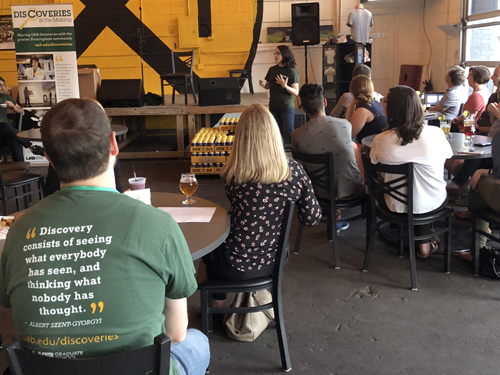Everyone has, at some point in their life, held a baby in their arms. They could be your children, grandchildren, niece or nephew or siblings. Have you ever stopped to wonder how many things must have happened perfectly in sync from the time the baby is a single cell in the mother’s womb to the time that you hold it in your arms? There is an unimaginable number of tiny things that can go wrong in the process, even in a single organ like the heart. When that occurs, the baby is said to have the congenital heart defects (CHD).
 Melissa Bentley a PhD in the UAB Graduate Biomedical Sciences Program, describes how her work can contribute to understanding CHD, which would ultimately help us to treat them effectively.
Melissa Bentley a PhD in the UAB Graduate Biomedical Sciences Program, describes how her work can contribute to understanding CHD, which would ultimately help us to treat them effectively.
What are CHD and its prevalence?
CHD are a group of conditions that all signify a problem in the structure of the heart present at birth. In the U.S. nearly 1 percent, or 40,000 of all infants, are born with CHD. Of those 40,000 infants, 25 percent are critical at birth and would need surgery within the first year of life.
“CHD are the leading cause of birth defects associated-illness and deaths in infants, and costs 1.9 billion dollars to treat annually,” Bentley said.
Primary cilium and its association to CHD
The primary cilium is a structure of the mammalian cell and every cell in the human body has its own primary cilium.
“The primary cilium has been ignored for a century after being discovered, as it was thought to be merely a vestigial organelle without important function. Only recently it has been found that the primary cilia of each cell communicate with each other during the developmental stages of a fetus and are important for the development of different structures of the body like the brain, finger and the heart. Interestingly, almost 20 percent of the genes that are known to cause CHD are related to the primary cilium,” Bentley said.
According to Bentley, understanding the primary cilia, which she refers to as the “cells antenna, as they communicate with other cells” would help us better understand the CHD.
Study of primary cilia and CHD
Bentley’s research is to understand what might be happening in human patients by studying different animal models. Her lab studies animals like roundworms, zebrafish and mice to ascertain how the primary cilia may cause CHD. Her current focus is to study two genes Nphp4 and Bbs5 that are affected in CHD. These genes not only affect the heart but also cause other defects. Nphp4 gene is linked to kidney disease and Bbs5 is linked to Bardet-Biedl Syndrome (causes vision loss, childhood obesity and children may have extra fingers or toes). To study the changes caused by these genes Bentley uses traditional techniques of histology, which is to look at the structures of a tissue under a microscope to see its changes. She also uses a modern technique known as µCT (Micro-Computed Tomography).
“µCT is nothing but X-ray imaging in 3D” Bentley said.
This technique enables us to study the structures of the developing heart in detail. Then comparisons can be made between the normal developing heart and an affected heart, to understand what changes occur at what point in time.
How will this study help people?
Understanding why CHD happens can help us provide insights into ways which can be used to treat it effectively. This will also have the potential for genetic counseling, and parents can make informed decisions well in advance.
“This will have the potential to have more informed treatment for non-cardiac associated symptoms, as 23 percent of CHD patients also suffer from kidney and urinary abnormalities,” Bentley said.
Thus, it may be possible to imagine a future in which CHD and associated problems are not affecting so many children and those it is affecting would be treated with much more ease.